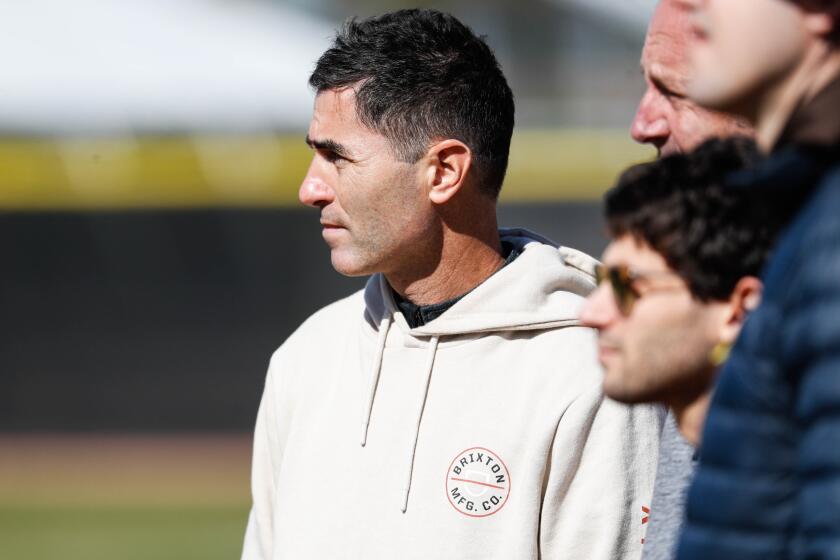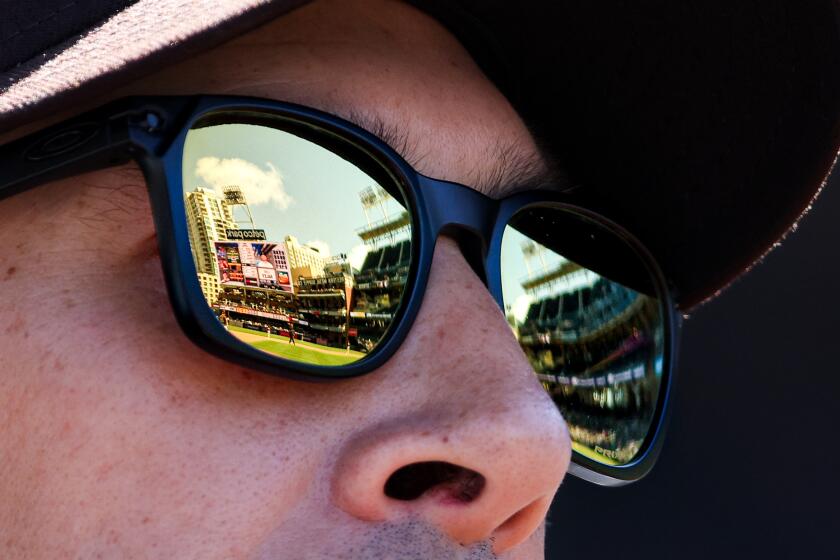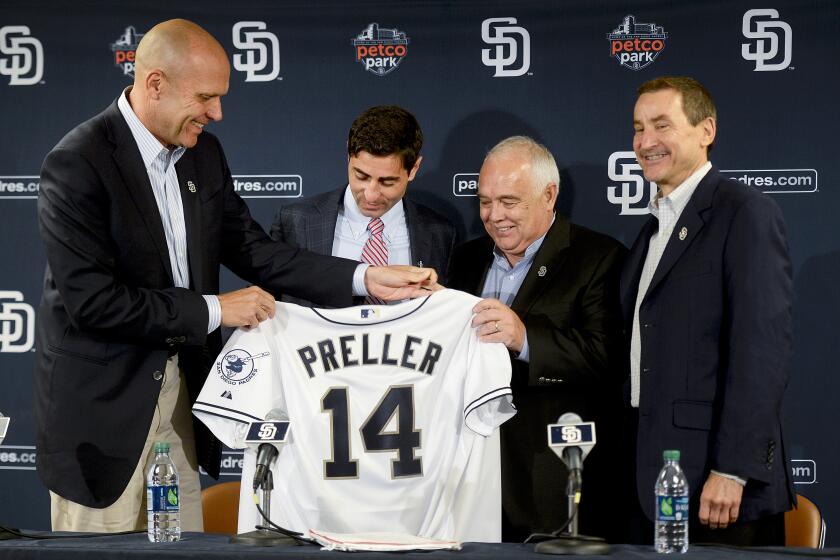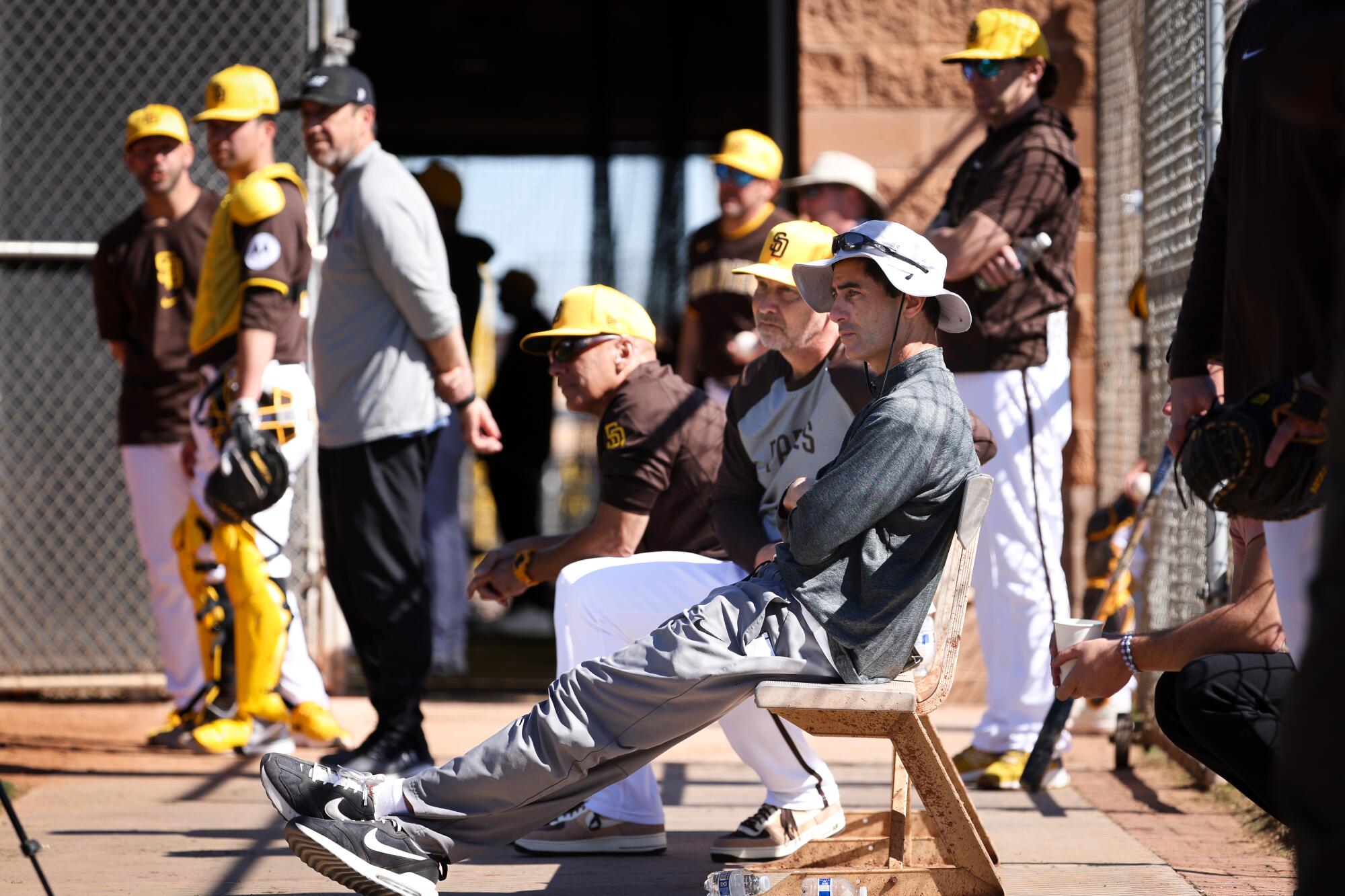
Padres President of Baseball Operations has built the Padres into a franchise that expects to win, which could ultimately contribute to his undoing
He could convince his first boss just enough and found a soulmate/enabler in his second boss. His third boss has effectively put him on notice.
The Padres weren’t really trying to win almost the entire first half of his tenure. They have been to the playoffs twice in the past four seasons but know they should have been at least once more. There have been statue contracts and stake-in-the-ground contracts and questionable contracts. There have been lineups full of stars. Record crowds have filled Petco Park, cheering and chanting and sometimes booing.
And he is the one who made it this way.
It has been quite a ride, this decade of the Rock Star G.M.
A.J. Preller has begun his 10th season in charge of baseball operations for the Padres with a mandate that he will be “accountable” and the real possibility that he finally will have gotten caught up in all the rope he has been extended.
Or maybe his trade for a frontline starter earlier this month, which once again ignited excitement and confidence among fans and players, hinted at him once again being able to engineer a winner.
Whether Preller has made the Padres better in the lasting way he and ownership promised is a question that can be debated.
For all that has happened in his time — the building and pillaging and rebuilding of the minor league system, the frequent remakes of the major league roster, all the turnover and trades and drama — there can be no question Preller has made the Padres far more interesting than they were for most of the four decades before he arrived.
Well before Peter Seidler was seen as a savior, Preller was the one who changed the thinking of a franchise and a fanbase.
Seidler often talked about the “art of the possible.” Preller introduced the Padres to the concept.
Front office employees who preceded Preller and are still in his employ talk of a culture of can’t that had long been the norm in San Diego. Being the small-market, low-budget Padres meant there were limitations. It was a sort of lightning-in-a-bottle approach to winning that, outside the four playoff appearances in Kevin Towers’ 15 years as general manager, had resulted in one postseason berth in 30 other seasons the franchise had been in existence before Preller was hired near the end of 2014.
“A.J. came in unencumbered with any beliefs that there was something we couldn’t do,” said Ron Fowler, the team’s Executive Chairman at the time of Preller’s hiring and a longtime Padres minority owner and San Diegan. “He came in with a blank sheet of paper, and he said, ‘Let’s go.’ ”
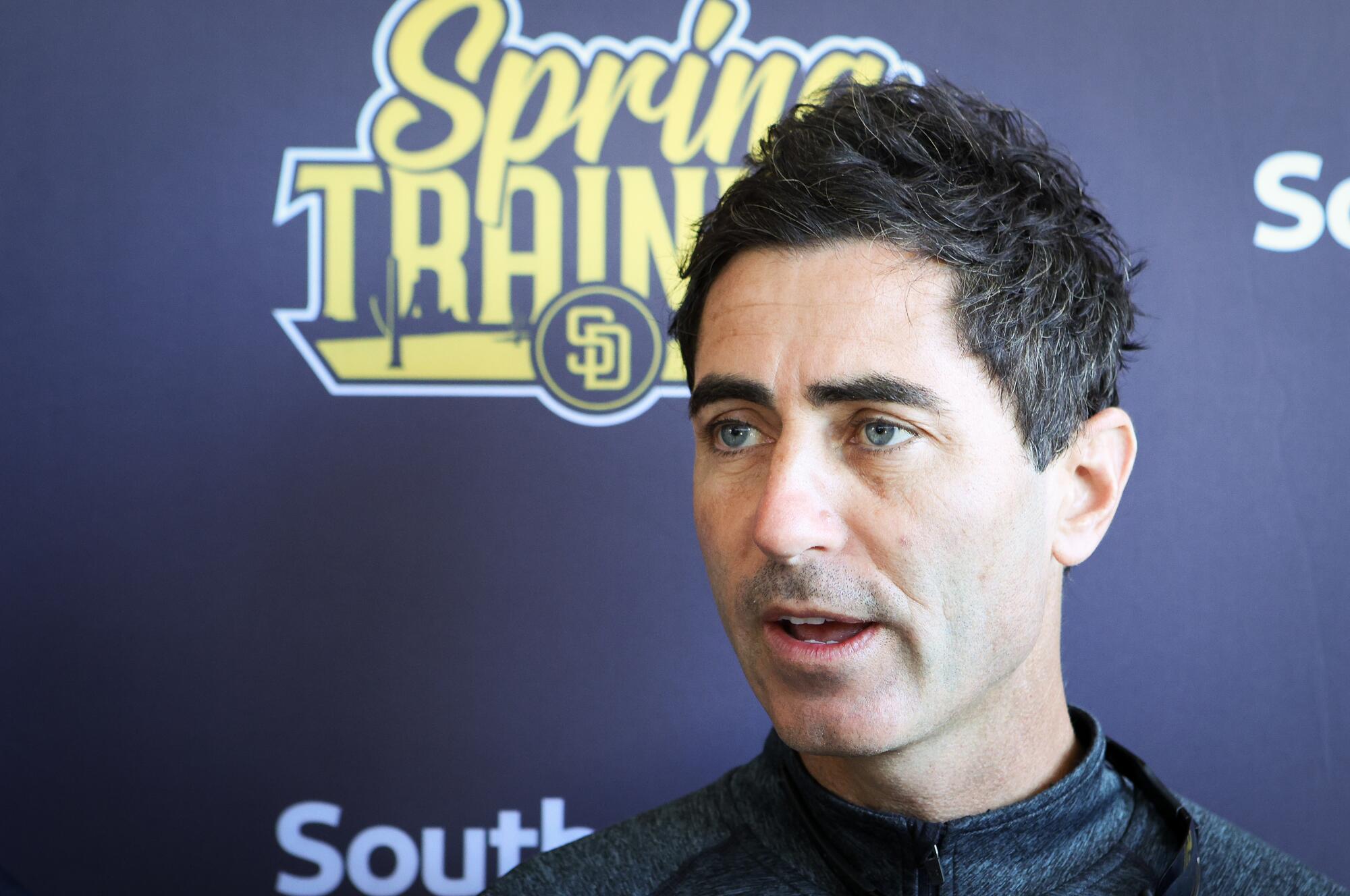
Has it gone well enough?
There are many ways to quantify the success of the Padres under Preller, and how the team has fared with him as its architect certainly looks better in relation to the franchise’s rather pathetic history.
From their inception in 1969 through 2014, the Padres’ .464 winning percentage was the worst among the 24 teams that had been around that long. From Preller’s first season in 2015 through 2019, their .469 winning percentage ranked 22nd among MLB’s 30 teams. Since 2020, when the Padres opened their stated window of contention, their .526 winning percentage is tied for 10th best.
The Padres are one of 12 teams to have made the postseason more than once in the past four seasons. They are one of seven teams to have won at least three playoff series in that span. That’s pretty good for a team that from 1969 through 2019 went to the postseason five times and won a total of three playoff series.
The Padres also committed more to payroll than all but four teams between 2020 and ‘23.
It seems likely, based on what has been expressed inside the organization and around the league, that how the 2024 season goes will determine whether Preller gets an 11th season.
What exactly needs to happen for Preller to remain is not known, though it appears to hinge to some degree on the team making the playoffs.
Also seemingly factored in, based on conversations with people in the organization, is how prospects such as Jackson Merrill fare this season. Preller’s ability to build, deplete and rebuild the organization’s minor league system might be akin to multiplying loaves and fishes. But the demand now is for more of those players to make it to the big leagues and be significant contributors on a team that is expected to compete for the playoffs every season and make the playoffs far more often than not.
The only on-the-record comment there is to go on is this from acting team Chairman Eric Kutsenda in February:
“A.J. is a pro. He’s maybe the best talent evaluator in baseball. But Erik (Greupner, the Padres CEO) and myself and A.J., we’re all accountable. … We all have to accomplish our mission and serve this organization, and we’ll be accountable to do that. … We’re judged on what we do year in and year out. So, yes, there is a body of work. But we also have goals for this year. A.J. has got goals, Erik has got goals. I’ve got goals. And we’re going to be judged on whether or not we can accomplish those goals. So, like I said, A.J. is a pro. He’s a big part of the organization, but we are all expected to perform at a very high level.”
Two things make this statement far less innocuous than it might seem on its own merit.
First, it was a contrast from anything the late Seidler ever said about Preller’s job status. In comments both public and private, Seidler was never anything but all-in on Preller’s vision.
And saving Preller was essentially Seidler’s final act as team owner.
Multiple sources said it was the Padres’ chairman, who had been mostly out of contact for weeks while battling illness, who decreed in late September that Preller and manager Bob Melvin would return. To that point, with Kutsenda working as Seidler’s proxy alongside Greupner, indications had been that Preller was fighting an uphill battle to keep his job amid the struggle between him and Melvin.
AJ Preller is entering his 10th full season as the Padres’ chief baseball decision-maker.
Just four men responsible for making their team’s baseball decisions have been in their current position longer than Preller. The Yankees’ Brian Cashman, Cardinals’ John Mozeliak and Nationals’ Mike Rizzo have constructed World Series champions. The Guardians’ Chris Antonetti has put together a World Series entrant and five other playoff rosters.
Any sober analysis of Preller’s tenure must acknowledge the team basically punted on four seasons near the start of his time in charge of baseball decisions while they focused on amassing talent in the minor leagues. But the rebuild of 2016-19 was to be a setup for the 2020s being what Seidler once called the Padres’ decade.
That window of contention’s yield over four seasons: a postseason appearance in 2020; a historic collapse brought on largely by injury in ‘21; another postseason appearance in ‘22; and an epic disappointment brought on largely by underachieving in ’23.
Preller is not prone to getting defensive. He does, however, push back on the idea that this up-and-down stretch has been a failure.
“I think it would be a very different narrative if you hold a very big lead in ‘21 or you play two games better last year,” he said. “Now, it’s three (playoff appearances) in four years, and now you get another crack to go play in the postseason. That’s the margin in baseball. It definitely slim. … The idea is get to the playoffs, get there every year. We’ve been there twice in the last four years. To me now, the next step is like the consistency of being able to do it, you know, now three in five and four in six years. That’s what the next few years is going to be like.”
Preller’s reaction to the suggestion he might not be around for the entirety of that was not unlike his thoughts on his job security in past years.
“I think we understand the standard and how serious we are about playing winning baseball here in San Diego,” Preller said Tuesday. “Our standards are really high. Internally for myself, I take this very, very personally. I have a lot of passion and a lot of drive to win for the fans of San Diego, because I see how passionate they are about this team. Since I’ve been in this job, just bringing a winner to San Diego, that’s all this is about.”
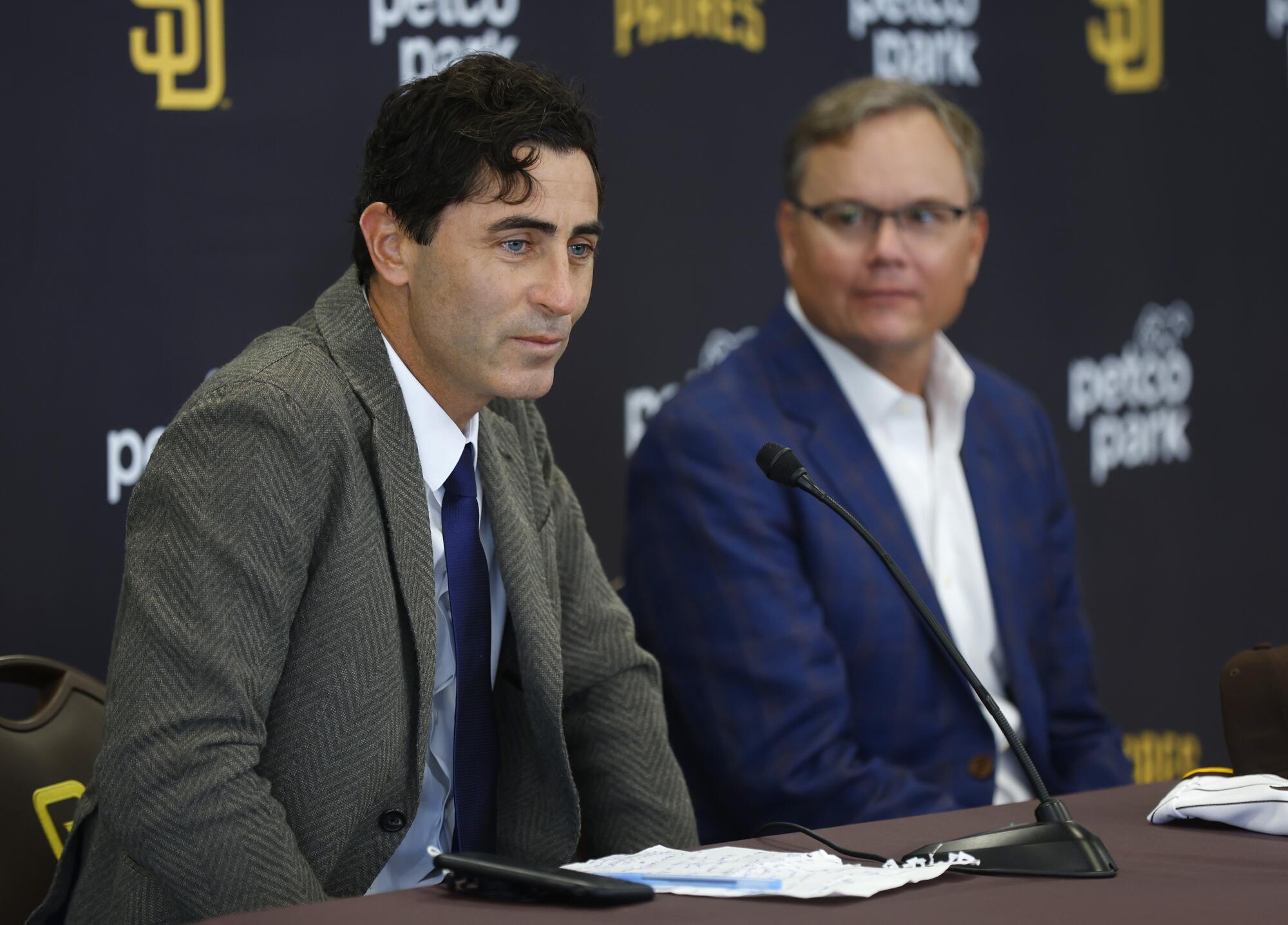
Relentless
The merits and perils of Preller’s management style have been discussed and debated plenty over the years.
But an overview is apt on the occasion of his marking a decade in charge.
He is on his third manager in five seasons and has been painted as grinding down the previous two — to the point with the last one that the men were hardly on speaking terms the final few months.
Preller is, almost no one will dispute, an acquired taste.
“You do have to learn him,” one member of the Padres’ front office acknowledged. “… He’s not for everyone. Obviously.”
Futures win lines, analytics models forecast 82 to 84 wins. Many other Padres teams beat projections; it’s time one of A.J. Preller’s clubs did it
The wheels in Preller’s head seemingly never stop, except perhaps for the three or four hours he sleeps most nights.
The assessment that he is the game’s hardest-working executive can’t be quantified. But it’s nearly impossible to find someone who doesn’t believe it to be true. Even Preller’s detractors — mainly consisting of those who used to work for him — attest to that.
Some of the issues seem to be the manifestation of a man’s best attributes being what can grate on some people the most.
There are few things so predictable as seeing a former Preller charge, now employed by another team, and that person volunteering how much more “relaxed” or “sane” or “normal” it is in their new job.
Preller’s allies allow that he is relentless and passionate. Those who know Preller and defend him do concede, as well, that he often lacks some of the traditional communication skills and social graces that might otherwise soften his intensity.
“The dial is turned really high,” one subordinate said recently.
Those who report to him must be prepared, virtually at all times, at the drop of a hat.
“He’s always on,” one employee said. “You have to be, too.”
Preller craves constant feedback, which brings us to the point of the most oft-repeated attack on Preller — that he doesn’t want feedback.
To many who work closest with him, this narrative is, in the words of one lieutenant, “a weird one.”
A.J. Preller has made trades with 27 big-league teams as he enters his 10th year as the Padres’ general manager
Preller includes in his coterie of advisers such varied personalities as Director of Player Health and Performance Don Tricker, hired in 2017 from his job as high performance director of New Zealand Rugby, and special assistant Bill Masse, a former Marlins executive. Among his most-trusted scouts is the legendary Logan White. Preller inherited and has steadily given more responsibility to lieutenants Josh Stein, Nick Ennis and Pete DeYoung. And Preller has seemingly also kept an elder statesman nearby. His mentor, Don Welke, was omnipresent until his death in 2018, and current scout Ron Rizzi is in his sixth decade working in professional baseball.
“I think it takes somebody that loves the game and loves the city of San Diego and has a lot of real baseball knowledge and content,” Preller said of the type of person who enjoys working for him. “We’re very open about like being very honest with areas that we’ve struggled in. We want people that are willing to speak their mind. That’s a huge part of it. And some people are very comfortable in that environment. Some people aren’t.
“A group in a room with six or seven people in there — scouting, player development, analytics — and throwing a topic out there and having an open conversation with the best ideas coming to the fore, to me, that’s the only way I really know how to do it. … People that are comfortable in that setting, they love it. It’s not right or wrong, but other people don’t quite see it that way.”
Mike Shildt, who was hired as manager in November, served the previous two seasons as a special assistant in player development and as an adviser to the major league staff. Preller declined to discuss his disagreements with Melvin this week, but the hiring of Shildt said all anyone needs to know about what Preller felt went wrong with Melvin.
From the start, Shildt has espoused a philosophy of alignment and group decision making.
Preller does not insist on control over lineups, scripts for bullpens and in-game strategy, his managers have said. There does, though, seem to be a gray area between insistence and interference.
The way Preller asks questions, forcefully and repetitively, has been interpreted by many as making demands. Over several years, those who work with him say that is not the case. And even some former subordinates who have said he told them to do something a specific way have relented on further reflection that he did not actually say how something had to go but that they inferred a demand and/or were simply tired of the constant churn of ideas and debating.
Debate is a big part of what Preller and his inner circle do.
Those who work with him say it is common for Preller to state an idea with such conviction that it might seem he could never be swayed otherwise, only to have him listen to a subordinate and accede to that person’s vision. According to those in his inner circle — i.e., the ones in on the meetings — Preller sometimes goes an entire meeting without saying more than a few words. He also frequently asks a lot of questions in order to draw the conviction from a scout.
“He wants to know why,” one close adviser said. “He wants to know process. He takes in a lot of information, a lot of ideas and produces a lot of ideas.”
It is that relentless pursuit of best practices when managing down, his allies contend, that has enabled Preller to manage up so effectively. Even before Seidler took over as control person, the Padres had increased payroll three straight years.
“Some it worked out, some of it didn’t,” Fowler said of Preller’s constant flow of ideas. “He kept on tinkering, kept on doing things — all of them to win. … He was sort of fearless. Sometimes you have to put a boot up somebody’s butt to get them to do anything. A.J. was the complete antithesis of that. You had to put the leash on him and pull on the choke collar. He was an E-ticket ride.”
While colleagues say Preller is in recent years noticeably more cognizant and providing of allowances that his employees have families and obligations he does not, he otherwise defends his management style.
“I treat people with a lot of respect,” he said. “I’m very open. Sometimes I think the openness, probably for some people, it’s hard for them to handle that. They probably may want more of a thumb on you. … And I think we operate more like, ‘Hey, here’s the issue. Here’s the problem, here’s the goal, this is the end game. Now how do we get there?’ There’s a lot of different ways to get there. And some people work well in that structure. Some people don’t. But I don’t really think we should change that. I think that’s a good way to go about doing it, honestly.”
Too much of a good thing?
Preller’s allies have often marveled that the biggest gripes against him seem to boil down to his working too hard and wanting to win too much.
None of them are willing to speak publicly. But Fowler has no such qualms.
“He doesn’t suffer fools well,” said Fowler, who was the Padres’ control person from the time the group headed by him and Seidler bought the team in August 2012 through late 2020. “He works harder than 99 percent of the people in baseball — player development, executive-level people. And it’s solamente baseball. Some people misread that.”
There is no doubt Preller’s sole focus is making the Padres as good as possible. The Padres have since 2020 made the ninth-most trades in baseball. It just seems like more, because no G.M.’s transactions have dominated the conversation as much as Preller’s have.
His overhaul of the Padres’ major league roster, which began less than four months into his tenure, was the talk of the 2014-15 offseason. So, too, his subsequent dismantling of that roster to build what would become the game’s top minor league system was heralded.
And after four years ostensibly spent building up the minor league system — with detours to add Eric Hosmer in February 2018 and Manny Machado a year later — Preller embarked on a transaction bender.
The Padres made 20 trades between November 2019 and January 2021. His acquisition of eight players at the trade deadline in 2020 and two trades plus the signing of Ha-Seong Kim that December made the Padres the talk of the league. Preller’s moves in those 15 months included the acquisitions of Tommy Pham, Jake Cronenworth, Mike Clevinger, Jurickson Profar, Yu Darvish, Blake Snell and Joe Musgrove.
The implosion of 2021, which included a near miss on Max Scherzer at the trade deadline that season, occupied Preller for a while.
He was back at it in the days leading up to the 2022 season, trading for starting pitcher Sean Manaea and closer Taylor Rodgers. That was an appetizer for what came at the trade deadline — with the Padres acquiring arguably the game’s best closer (Josh Hader) and one of the best hitters (Juan Soto) on back-to-back days at the start of August.
This offseason, he made the biggest deal of the winter meetings, trading Soto to the Yankees for five players — and the biggest deal of spring training, acquiring starting pitcher Dylan Cease from the White Sox.
Preller sees there being just two “phases” of his tenure, even if it seems like he has remade the roster many times, has cycled through multiple coaching staffs and is now working with his fourth full-time manager.
“I got the job because the organization wasn’t being ultra successful,” he said. “So I think the first first four-plus years or five years, the idea was to grow the talent base so that we can look up in the 2020s and have a very successful decade and make sure that our systems, our processes, our people, our talent was in a spot that every single year we had a chance to play deep into October.”
For him, that last part is the one to note when assessing how he has gone about his job.
Teams like the Rays and Guardians have built from within, a cost-effective route they have taken to repeated postseason berths but no championships and paltry attendance.
Preller has veered a direction in which his best prospects have become not Padres, but currency.
“I used to feel like, ‘Man, this all-homegrown team would be the most amazing thing,’ ” Preller said. “But no matter how good you are in scouting (and) in development, that’s probably unrealistic.”
By that, he meant that route would likely not lead to the downtown streets hosting a parade.
Preller contends the Padres could have kept many of the nearly 30 top-30 prospects they have traded away since 2019 and had them form the core of a perennial playoff contender. It is his belief, however, that while Cal Quantrill is a fine piece in a rotation, it is Darvish or Musgrove or Cease that should be on the mound in a playoff series.
“It doesn’t have to be one way to go about doing it,” Preller said. “The biggest thing is always you have to have great players that people want to come see play. … We felt like we’d be successful either way. Just a different type of success — a team that you feel like could probably get to the playoffs, be like a very good dollar-per-efficiency team. That team is winning ‘X’ number of games. But do you really have a chance to win the World Series? … We made some decisions to go get a Soto, a Hader, the offseason before that to get some starting pitching, to go get some players that we felt like you can win a World Series with.
“That’s the biggest thing we talk about all the time is, you look at the 49ers, the Patriots, the Warriors. These were not perennial superstar franchises until the ownership group, some phenomenal players and phenomenal coaches got together and did what they had to do to get them there. You can win anywhere, and you can create an amazing product.
“You have to have great players.”
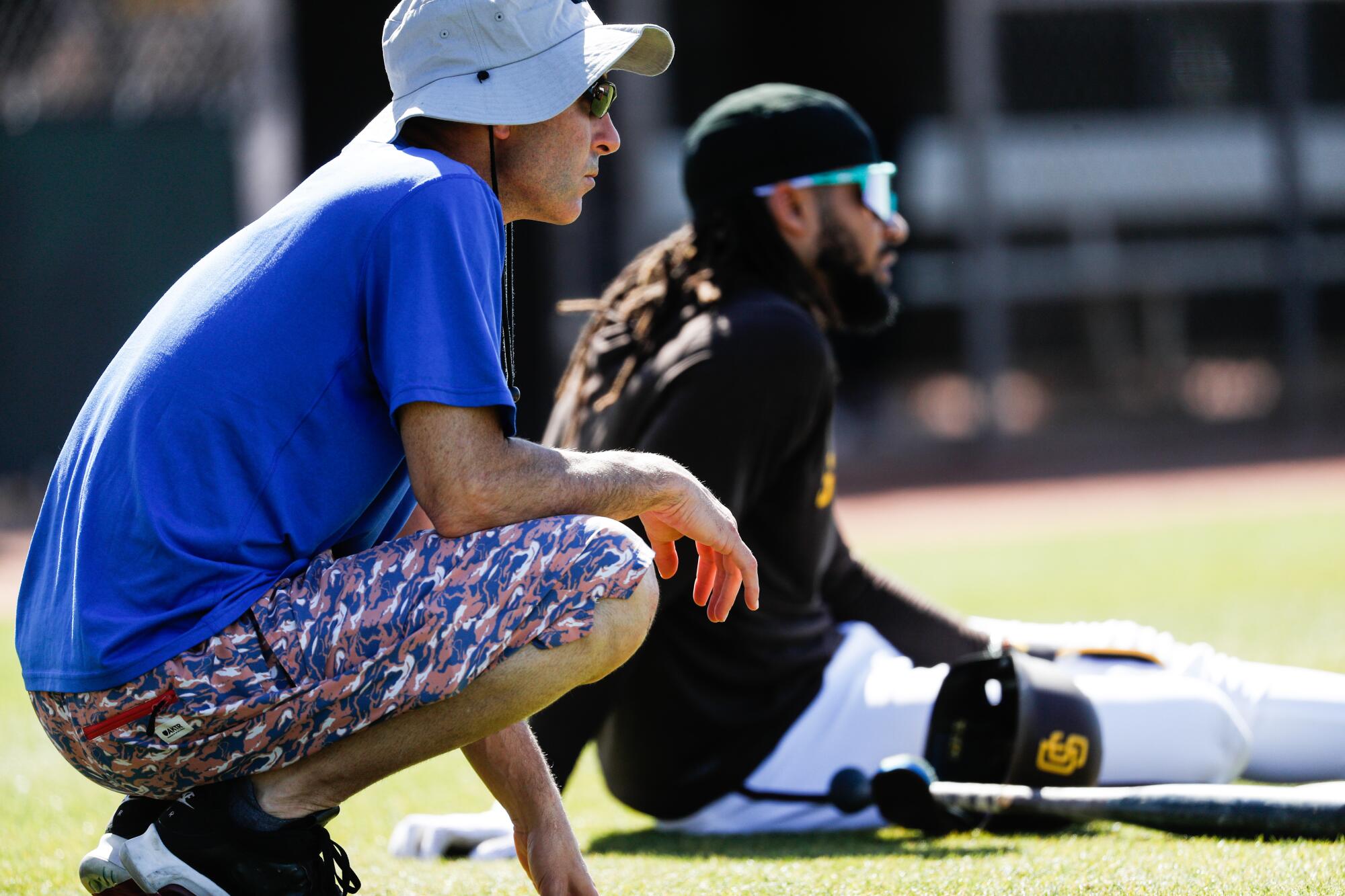
Signpost, potholes
Preller’s first direction was to assemble a roster he always intended to dismantle. The hope was that the 2015 team that excited the fanbase as it was being built would keep their interest throughout the season and squeak into the playoffs, signaling a new frontier for the franchise. That team flared out by summer.
But the selling off of parts that commenced the following November with the trade of Craig Kimbrel for four highly touted Red Sox prospects and resulted in the June trade that turned James Shields (and $31 million) into Fernando Tatis Jr. was always envisioned.
Acquiring Tatis — not to mention the enabling of deals that built the core of the Padres’ only two playoff teams in the past 17 years — arguably makes that process a success on its own.
But Preller and his team — “ultimately they’re my decisions; I’m the G.M,” he said — have made some bad calls along the way.
Notable among them: The Padres impetuously traded eventual All-Star Trea Turner as part of the effort to get enough major league talent to field a competitive team in 2015. They included Emmanuel Clase, who has led the majors in saves the past two seasons, on a list of potential players to be named later in a trade for a Triple-A catcher. They overvalued catcher Austin Nola to the point of giving away Ty France and Andrés Muñoz to get him.
And they spent a lot of money on Hosmer. It was a $144-million investment in a World Series winner they believed would perform well enough while being a leader that showed the way of being a big-leaguer to young players and demonstrated to potential free agents that San Diego was a valid destination.
They got but a portion of that from Hosmer, who ended up providing a 3.6 WAR over 4½ seasons before the Padres paid the Red Sox to take him in August 2022.
“We call it a stake-in-the-ground player,” Preller said. “Just basically signaling to the rest of the league … I think the perception from a lot of agents, players was that San Diego wasn’t really going to be a player in a free-agent market for an impact player or an established player. Eric, him coming here, the No. 1 thing was to play well and to perform. Obviously, we evaluate that. But I do think like Manny coming here a year later, I’m not sure if it just automatically was like if you spend the most money he would have come here (without Hosmer being here).”
Part of what Preller will be evaluated on going forward is a few more recent deals, including how Cease and the players acquired for Soto perform, as well as how Machado and Xander Bogaerts fare in the second year of their mega contracts.
Criticism of those two deals centers not on the quality of the players but on the timing of the deals. Machado’s 11-year, $350-million pact was agreed to a year before he went to free agency. Bogaerts’ 11-year, $280 million deal was about twice as long and for about $80 million more than his next-best offer.
Any judgment has to include the fact Seidler played a large role in pushing both deals across the finish line.
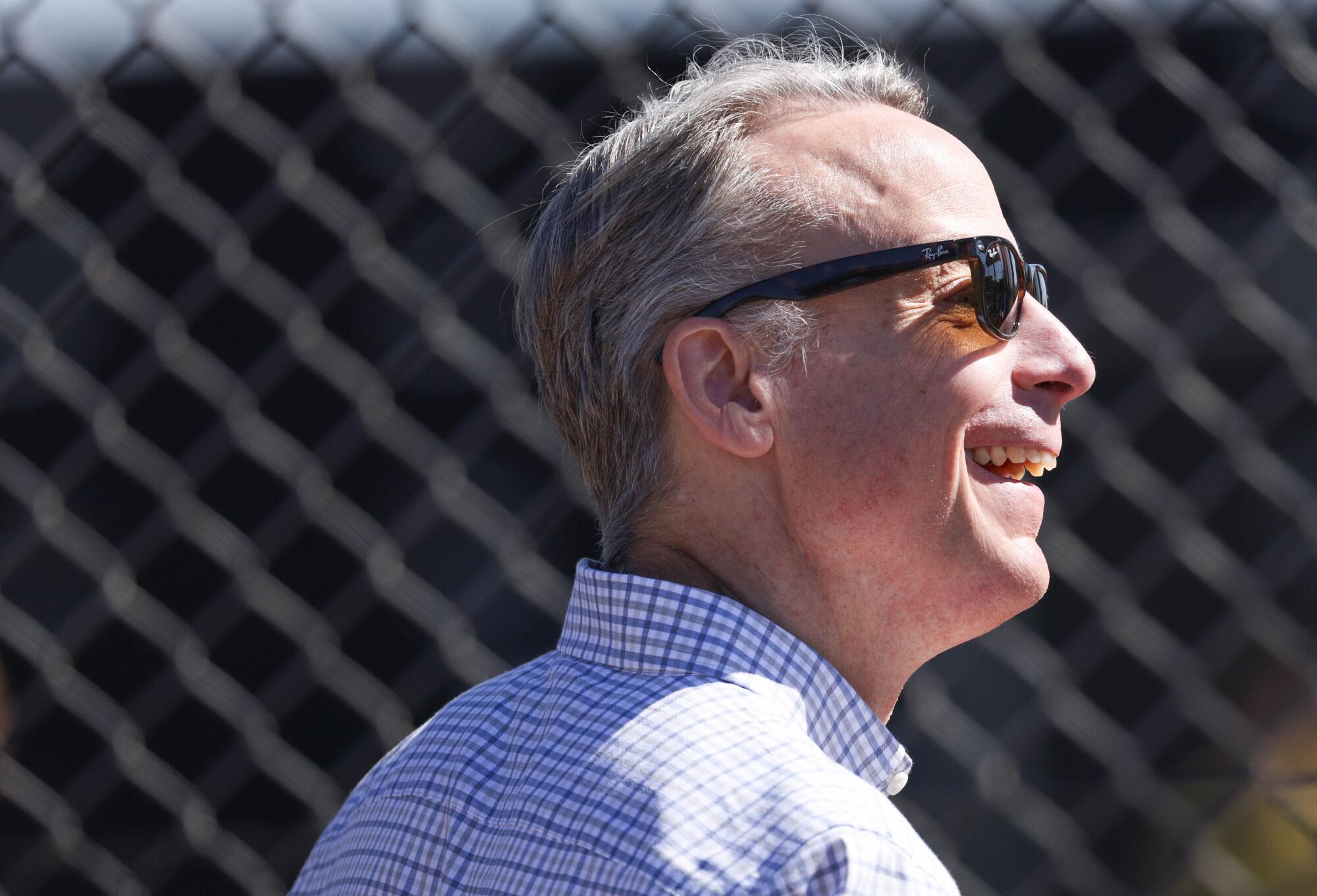
And now?
Preller now answers to a new kind of boss in a new time.
Kutsenda, a trusted business partner of Seidler’s, is expected to remain as the franchise’s control person at least through the end of this season. In terms that are only slightly too simplistic, Preller went from having to sell Fowler to having a willing partner in Seidler.
Fowler, who made his many millions running many businesses, was far more risk-averse than Seidler was. But Fowler still oversaw a significant increase in spending, and the Padres ranked 11th in payroll commitments his final season in charge.
A CPA by training, Kutsenda is overseeing implementation of a transition from Seidler’s fairly freewheeling spending.
“We’ve been through different setups,” Preller said. “... Now it’s set up where Eric Kutsenda is my direct report. Everyone has had their different styles, different working relationships. Biggest thing, though, that I’ve been lucky about is everybody wants to win. I think there’s a respect factor there that everybody I’ve worked for has brought to the table. I can see that with Eric Kutsenda as well. He respects the process. He’s hungry to win as well.”
Some of the Padres’ payroll paring — more than $100 million from last year’s final tally — is part of a long-term plan Greupner elucidated even before 2023 began. Some of it is due to the Padres’ need to get under MLB’s allowable debt service limit.
The Padres still rank 15th among the 30 MLB teams, beginning the season with a $153 million payroll.
“The payroll component depends on where you’re at from a competitive cycle, depends on where you’re at from the minor leagues and who’s going to contribute for you there,” Preller said. “You can win at all different levels. To me, it creates some different challenges, different questions that need to be answered. But I think we have plenty of finances and resources to win baseball games, and we have a good roster.”
Go deeper inside the Padres
Get our free Padres Daily newsletter, free to your inbox every day of the season.
You may occasionally receive promotional content from the San Diego Union-Tribune.
